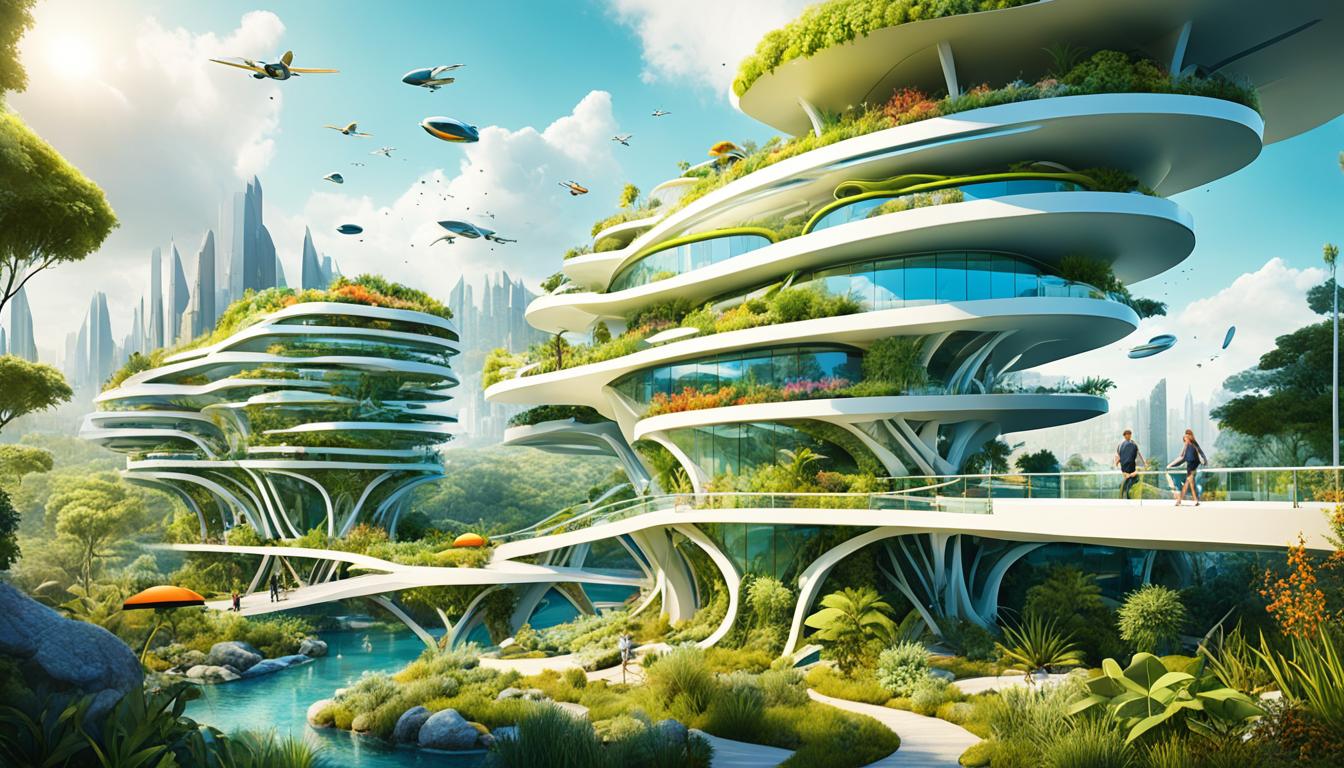
Imagine walking through a bustling city, surrounded by towering buildings and busy streets. As you make your way through the urban landscape, your eyes catch a glimpse of something unexpected – a lush green rooftop garden teeming with vibrant flowers and buzzing with life. This sight, in the midst of concrete and steel, is a testament to the innovative approach that architects and designers are taking to prioritize biodiversity.
In today’s world, where environmental sustainability and ecosystem preservation are at the forefront of global initiatives, architects and designers play a pivotal role in incorporating conservation practices into their projects. They have embraced the challenge of balancing urban development with the protection of wildlife and the natural environment.
From green infrastructure to sustainable building practices, these architectural innovations are reshaping the way we design our cities and communities. By weaving nature into the fabric of our built environment, architects are not only creating aesthetically pleasing spaces but also safeguarding vital habitats and contributing to wildlife protection.
In this article, we will explore the importance of biodiversity in design, innovative approaches to biodiversity integration, and showcase how countries like Ecuador and Guatemala are leading the way in sustainable architecture. Join us on this journey to discover the extraordinary ways architects are forging a path towards a more harmonious and sustainable future.
Key Takeaways:
- Biodiversity plays a crucial role in sustainable development and environmental well-being.
- Architects and designers can enhance the environmental and social benefits of their projects by incorporating biodiversity.
- Innovative approaches such as green infrastructure and sustainable building practices prioritize wildlife protection.
- Ecuador and Guatemala are exemplary countries in implementing sustainable architecture and biodiversity integration.
- Architectural innovations contribute to conservation efforts and create a sustainable future for both humans and nature.
The Importance of Biodiversity in Design
Biodiversity plays a critical role in promoting sustainable development and ensuring the overall well-being of our environment and society. Incorporating biodiversity into design projects is key to unlocking a range of benefits for both human and natural systems.
Designers and architects have the unique opportunity to harness the power of biodiversity to create spaces that not only function aesthetically but also provide essential ecosystem services. By prioritizing biodiversity in their designs, they can contribute to the environmental well-being of our planet and support sustainable development.
One of the primary benefits of incorporating biodiversity into design is the provision of vital ecosystem services. Biodiverse landscapes offer food security by promoting the growth of diverse plant species that support a range of pollinators and enhance crop yields. These landscapes also contribute to water purification by filtering toxins and impurities from runoff, promoting cleaner water sources.
“Designing with biodiversity in mind allows us to create spaces that promote the natural functioning of ecosystems, leading to enhanced climate regulation and disease control,” says renowned architect Jane Williams.
Biodiversity also plays a crucial role in climate regulation, helping to mitigate the impacts of climate change. By incorporating biodiverse elements such as green roofs and vertical gardens, architects and designers can reduce the urban heat island effect and lower energy consumption for cooling. These elements also act as carbon sinks, absorbing and storing carbon dioxide, a major contributor to global warming.
Furthermore, biodiversity in design can contribute to disease control by creating healthier environments. By incorporating natural habitats and green spaces into urban areas, architects and designers can support the presence of diverse flora and fauna, which helps regulate disease-carrying populations and ultimately promotes public health.

Enhancing Environmental and Social Benefits
By integrating biodiversity into design, architects and designers have the opportunity to enhance both the environmental and social benefits of their projects. Designing with biodiversity in mind fosters a sense of connection to nature, improving mental well-being and overall quality of life.
In addition, incorporating biodiversity can create opportunities for educational and recreational activities, offering spaces for the community to learn and engage with the natural world. These spaces become hubs for environmental education and inspire individuals to make sustainable choices in their everyday lives.
Ultimately, the importance of biodiversity in design cannot be understated. Architects and designers have the power to shape our built environment in ways that support the health and well-being of both humans and the natural world. By prioritizing biodiversity, they can pave the way for a more sustainable and resilient future.
Innovative Approaches to Biodiversity Integration
In recent years, innovative approaches have emerged in the field of architectural and urban design, focusing on the integration of biodiversity. Architects and designers are recognizing the importance of incorporating green infrastructure and sustainable building practices to preserve wildlife habitats and promote the overall sustainability of built environments.
Green Infrastructure: Embracing Nature in Design
One of the key concepts in biodiversity integration is green infrastructure. It involves the deliberate creation of green spaces, such as parks, gardens, and rooftop gardens, within urban areas. These spaces provide vital habitats for plants, animals, and insects, fostering biodiversity within the built environment. They also serve as valuable recreational areas for communities, promoting well-being and connecting people with nature.
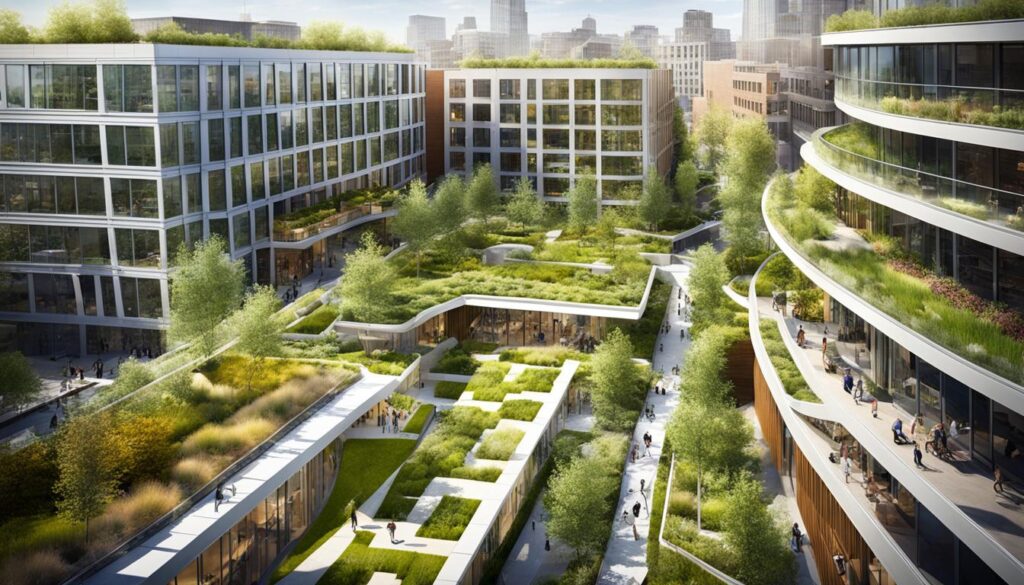
Green infrastructure not only enhances the aesthetic appeal of cities but also contributes to climate regulation by reducing the urban heat island effect and improving air quality. By incorporating plants and trees, it creates a natural cooling effect, reducing the need for energy-intensive cooling systems. The integration of green roofs and walls further enhances the energy efficiency of buildings and mitigates stormwater runoff, improving water quality and reducing flood risks.
Sustainable Building Practices: The Future of Architecture
Sustainable building practices are another key aspect of biodiversity integration. Architects and designers are adopting innovative techniques and materials that minimize the environmental impact of construction. These include the use of renewable energy sources, such as solar panels and wind turbines, to power buildings and reduce reliance on fossil fuels.
“Sustainable building practices not only benefit the environment but also enhance the health and well-being of occupants by creating healthier indoor environments.”
The incorporation of energy-efficient technologies, such as smart lighting and advanced insulation systems, reduces energy consumption and lowers carbon emissions. Additionally, sustainable building practices prioritize the use of eco-friendly materials that are responsibly sourced and have a lower negative impact on the environment.
A Holistic Approach to Biodiversity Integration
- Promote the integration of biodiversity in urban planning and design.
- Create green spaces and wildlife corridors to preserve and enhance ecosystems.
- Incorporate sustainable building practices to minimize the environmental impact of construction.
- Utilize renewable energy sources and energy-efficient technologies to reduce carbon emissions.
- Choose eco-friendly materials that are responsibly sourced and promote a circular economy.
By adopting these innovative approaches and integrating biodiversity into architectural and urban design, we can create sustainable built environments that not only benefit the natural world but also enhance the quality of life for communities. The preservation of biodiversity and the implementation of sustainable building practices are key steps towards a greener, more resilient future.
The Importance of Innovative Approaches
“Innovative approaches to biodiversity integration in design are crucial for addressing the pressing environmental challenges we face today. By embracing these approaches, we can create sustainable built environments that prioritize both the well-being of human communities and the preservation of our planet’s biodiversity.”
Biodiversity Conservation in Ecuador
Ecuador, known for its exceptional biodiversity and commitment to ecological conservation, has implemented sustainable architecture and green infrastructure in its urban development projects. With a focus on preserving its natural heritage and minimizing the environmental impact of construction, Ecuador sets a high standard for sustainable building practices.
“Our goal is to prioritize biodiversity preservation and create a harmonious coexistence between humans and nature,” says Luisa Gomez, the director of the Ecuadorian Environmental Agency.
By integrating biodiversity conservation into architectural design, Ecuador ensures that its built environments align with its natural landscapes. This approach not only benefits the environment but also enhances the quality of life for local communities.
Green Infrastructure: Enhancing Biodiversity Conservation
One of the key strategies employed in Ecuador’s sustainable building practices is the implementation of green infrastructure. This approach involves the creation of green spaces, wildlife corridors, and the use of sustainable materials.
- Green Spaces: Ecuador promotes the development of parks, gardens, and urban forests to provide a habitat for diverse plant and animal species. These green spaces also serve as recreational areas for residents, fostering a strong connection between nature and community.
- Wildlife Corridors: In urban areas, Ecuador focuses on integrating wildlife corridors to allow the safe movement of animals between different habitats. These corridors help mitigate the negative impact of fragmentation and promote biodiversity connectivity within the built environment.
- Sustainable Materials: Ecuador emphasizes the use of eco-friendly and locally sourced materials in construction projects. This reduces the carbon footprint associated with transportation and supports local economies.
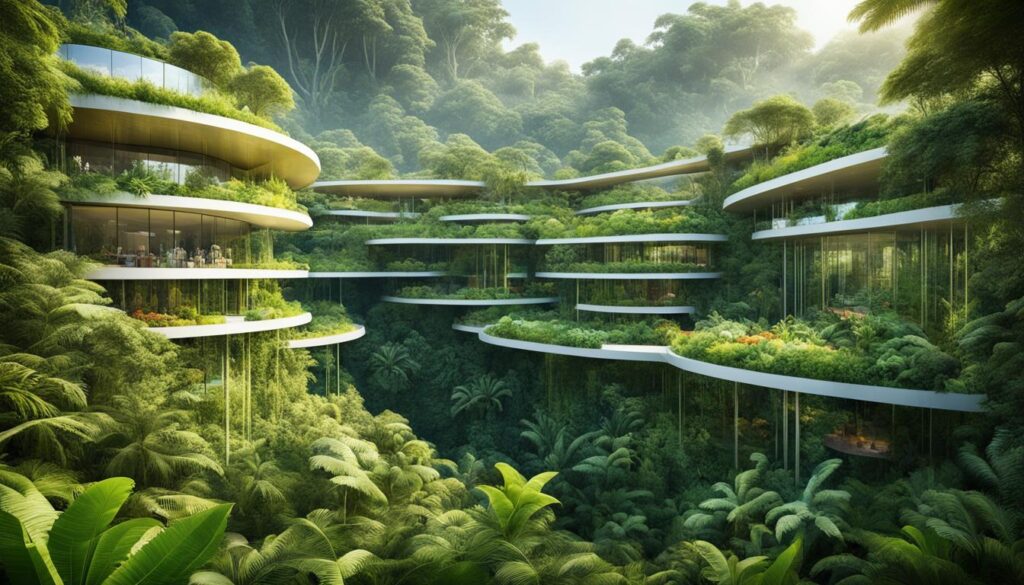
Preservation of Natural Heritage
Ecuador is committed to preserving its natural heritage through sustainable architecture and strategic conservation efforts. The country recognizes the value of its diverse ecosystems and seeks to protect them for future generations.
- Protected Areas: Ecuador has established a network of protected areas, including national parks, nature reserves, and biosphere reserves. These areas safeguard critical habitats and endemic species, contributing to global biodiversity conservation.
- Environmental Policies: The Ecuadorian government has implemented stringent environmental policies, regulating land use, conservation practices, and sustainable resource management. These policies ensure the preservation of Ecuador’s natural heritage and promote the integration of biodiversity into development projects.
- Community Engagement: Ecuador actively involves local communities in biodiversity conservation efforts. Through education and capacity-building programs, individuals are empowered to become stewards of the environment, contributing to the long-term sustainability of their surroundings.
With its dedication to biodiversity conservation, Ecuador serves as a role model for sustainable building practices and the preservation of natural heritage.
Recognizing Nature’s Rights in Ecuador
Ecuador has taken a groundbreaking approach to environmental stewardship by acknowledging the rights of nature in its constitution. This bold move demonstrates Ecuador’s deep commitment to sustainable development and responsible environmental practices.
Through the recognition of nature’s inherent rights, Ecuador strives to ensure the preservation of its rich biodiversity and promote a harmonious coexistence between humans and the natural world. By granting legal rights to ecosystems, rivers, and other natural entities, Ecuador acknowledges their intrinsic value and the need for their protection.
This progressive step sets Ecuador apart as a global leader in recognising the importance of environmental conservation and sustainable practices. By placing the rights of nature at the forefront, Ecuador strives to create a legal framework that supports the long-term well-being of its natural treasures.
“By acknowledging the inherent rights of nature, Ecuador pioneers a new paradigm of environmental stewardship, emphasizing the need for sustainable development and the preservation of our planet’s invaluable ecosystems.” – Maria Fernandez, Environmental Activist
Recognizing nature’s rights not only reinforces the importance of sustainable development but also promotes a shift in societal mindsets towards more ecological consciousness. It encourages individuals, businesses, and governments to consider the consequences of their actions on the environment and make informed decisions that prioritize the well-being of both present and future generations.
Ecuador’s commitment to recognizing nature’s rights serves as an inspiring example for countries around the world. By embracing this eco-responsible attitude, Ecuador showcases the transformative power of sustainable practices and paves the way for a more environmentally conscious future.
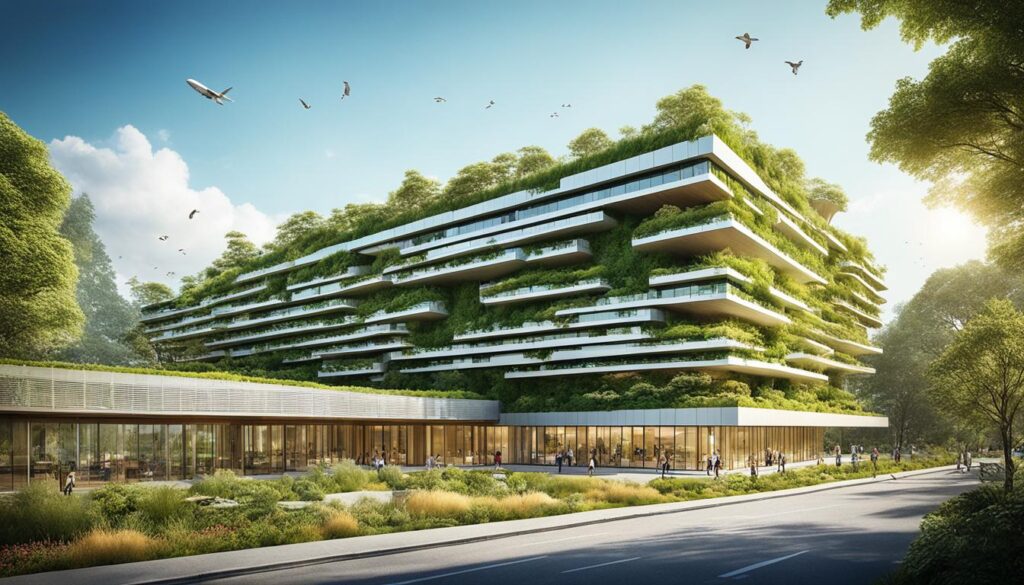
The Benefits of Recognizing Nature’s Rights
- Enhanced protection for ecosystems and wildlife habitats
- Promotion of sustainable development and responsible land use
- Strengthened environmental regulations and enforcement
- Encouragement of sustainable business practices and innovation
- Fostering a sense of environmental stewardship within society
Sustainable Architecture and Urban Planning in Guatemala
Guatemala is a leading advocate of sustainable architecture and urban planning, embracing eco-friendly practices and prioritizing the integration of biodiversity into its urban developments. This commitment to environmental preservation sets Guatemala apart as a progressive nation at the forefront of sustainable development.
The country recognizes the importance of sustainable architecture in creating harmonious urban environments that promote both human well-being and ecological balance. By incorporating eco-friendly practices and innovative design techniques, Guatemala showcases its dedication to creating sustainable cities that coexist harmoniously with nature.
“Cities must have a positive impact on biodiversity and promote a healthy environment for both humans and wildlife.” – Architectural Digest
Organizations Pioneering Biodiversity Integration
Guatemala’s commitment to biodiversity integration is evident through the work of organizations such as Long Way Home and the Hero School. These visionary organizations actively promote sustainable building practices while championing the integration of biodiversity into the built environment.
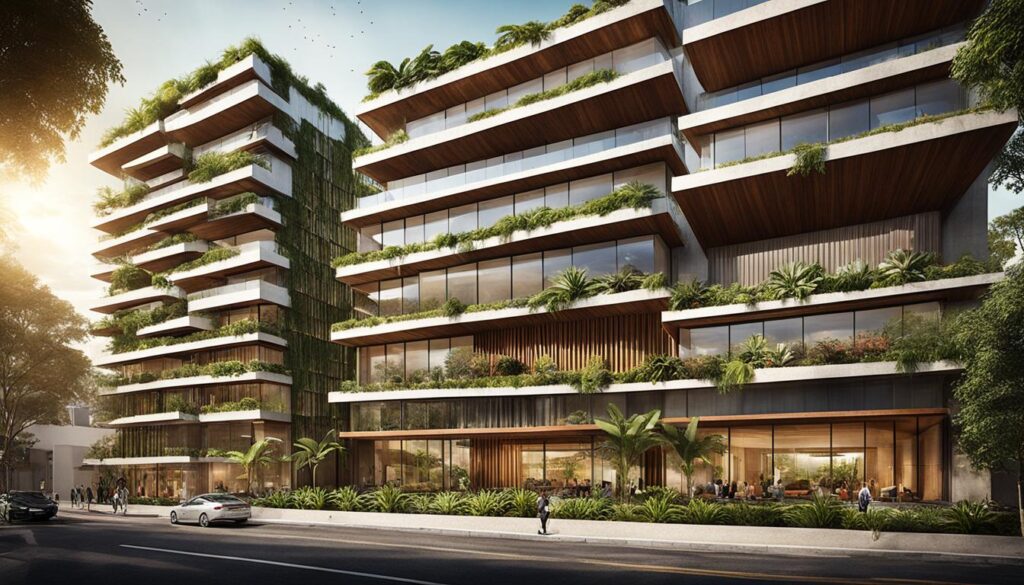
Long Way Home, a non-profit organization, focuses on sustainable development and education in Guatemala. Their projects utilize eco-friendly materials, repurpose waste, and create essential infrastructure while emphasizing the importance of biodiversity preservation. Through their efforts, they inspire local communities to embrace sustainable and environmentally conscious practices.
The Hero School, another notable organization, combines sustainable design and education to create buildings that serve as transformative spaces. Their commitment to biodiversity integration is demonstrated through the incorporation of green spaces and the creation of wildlife-friendly habitats within urban environments. By nurturing the coexistence of humans and nature, the Hero School sets an example for sustainable urban planning and architectural design.
Sustainable Architectural Design Firms
Guatemala’s sustainable architecture movement is further fueled by renowned firms such as PAZ Arquitectura and X-Architecture. These architectural practices are committed to creating spaces that harmonize with nature while incorporating innovative design elements.
| Architecture Firm | Notable Project | Sustainable Features |
|---|---|---|
| PAZ Arquitectura | Corallo House | – Utilization of eco-friendly materials – Energy-efficient design features – Integration with the surrounding natural environment |
| X-Architecture | Shilda Winery | – Thermal mass for temperature control – Water management systems – Integration of renewable energy sources |
PAZ Arquitectura’s Corallo House exemplifies sustainable design practices through its use of eco-friendly materials and integration with the surrounding natural landscape. This architectural masterpiece demonstrates the successful integration of sustainable practices with aesthetic appeal, showcasing the possibilities of sustainable architecture in Guatemala.
Similarly, X-Architecture’s Shilda Winery harmonizes with nature by incorporating sustainable features such as thermal mass for temperature control, water management systems, and renewable energy integration. This innovative approach to architectural design reflects Guatemala’s commitment to environmentally friendly development.
Guatemala’s notable architectural talents and organizations collectively contribute to the preservation of biodiversity and the creation of sustainable urban environments. Through their efforts, the country paves the way for a greener future, where architecture and urban planning coexist harmoniously with nature.
The Role of Long Way Home and the Hero School in Conservation
Long Way Home and the Hero School are two prominent organizations in Guatemala that are making significant contributions to sustainable development and green building practices. These organizations understand the importance of integrating biodiversity into their construction projects and have taken innovative steps to promote environmental conservation.
Long Way Home focuses on sustainable development by repurposing waste materials into building materials and constructing eco-friendly infrastructure. Through their projects, they not only create sustainable structures but also prioritize biodiversity integration. By incorporating green building practices, Long Way Home ensures that their projects have a minimal impact on the environment while benefitting the local communities. Their commitment to sustainable development goes hand in hand with their dedication to environmental education and community well-being.
“Our mission is to integrate environmentally friendly practices and promote sustainability in all aspects of our work. We believe that by prioritizing biodiversity and utilizing green building methods, we can create a more sustainable future for all.” – Long Way Home
The Hero School, on the other hand, focuses on empowering local communities and promoting sustainable development through educational initiatives. They provide environmental education programs that raise awareness about the importance of biodiversity and conservation. By educating and engaging the community, the Hero School inspires individuals to take part in sustainable practices and become environmental stewards.
Both Long Way Home and the Hero School serve as inspiring examples of how sustainable development and green building practices can be integrated into construction projects. Their efforts not only help in the preservation of biodiversity but also contribute to the overall well-being of communities and the planet.
Sustainable Design by PAZ Arquitectura in Guatemala
PAZ Arquitectura, a renowned architectural firm based in Guatemala, is at the forefront of sustainable design. Through their innovative projects, such as the Corallo House, they demonstrate a commitment to green building practices and the integration of eco-friendly materials and techniques.
The Corallo House, a true architectural masterpiece, exemplifies PAZ Arquitectura’s sustainable design philosophy. This stunning residential property seamlessly blends with the natural environment, harmonizing with its surroundings and minimizing its ecological footprint.
One of the key aspects of PAZ Arquitectura’s sustainable approach is their use of eco-friendly materials. By embracing sustainable alternatives, such as recycled and locally sourced materials, they reduce the environmental impact of their constructions while creating unique and aesthetically pleasing spaces.

Their projects also incorporate innovative design features that prioritize energy efficiency and conservation. Through thoughtful architectural choices, such as natural ventilation, passive cooling systems, and efficient insulation, PAZ Arquitectura reduces energy consumption and promotes sustainable living.
“We believe that sustainable design should go beyond aesthetics. It should be a way to integrate nature, minimize environmental impact, and create spaces that enhance the well-being of both occupants and the planet.” – PAZ Arquitectura
PAZ Arquitectura sets a remarkable example for sustainable architecture and the integration of nature and design. Their commitment to green building practices and eco-friendly materials showcases the possibilities of sustainable design in Guatemala and beyond.
A Focus on Sustainable Architecture by X-Architecture in Guatemala
Guatemala is at the forefront of sustainable architecture, and one of the key players in this field is X-Architecture. X-Architecture’s commitment to sustainable development and green building design is exemplified in projects like the Shilda Winery. This architectural masterpiece showcases the integration of sustainable practices and renewable energy integration.
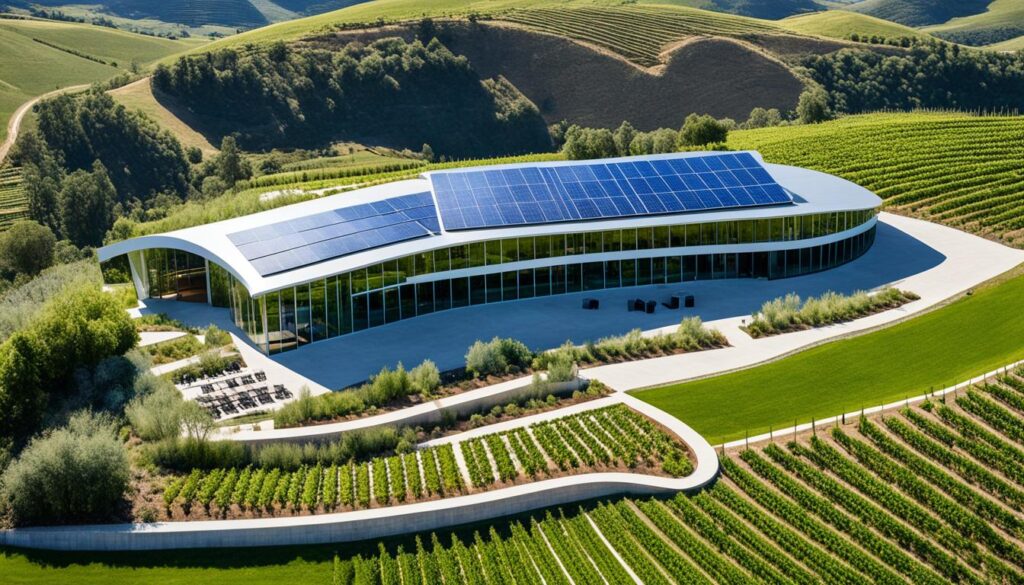
The Shilda Winery by X-Architecture is a prime example of sustainable architecture in Guatemala. This project embraces the natural surroundings and harmonizes with the environment, blending seamlessly with the scenic landscape.
To ensure energy efficiency and temperature control, X-Architecture incorporates thermal mass in the design of the winery. This strategy helps regulate the indoor temperature by utilizing the natural energy storage capacity of the building materials. As a result, the winery reduces its reliance on mechanical heating and cooling systems, making it more energy-efficient and sustainable.
The integration of water management systems is another noteworthy aspect of X-Architecture’s design philosophy. The Shilda Winery utilizes rainwater harvesting techniques, responsible water usage strategies, and innovative irrigation systems. These practices minimize water consumption and promote sustainable management of this precious resource.
Renewable energy integration is a core principle for X-Architecture. The Shilda Winery embraces this by incorporating solar panels and other renewable energy sources. These technologies provide clean and sustainable energy to power the winery’s operations, reducing its reliance on fossil fuels and minimizing its carbon footprint.
Through their work, X-Architecture showcases the possibilities of sustainable architecture in Guatemala. They demonstrate that it is possible to create buildings that not only enhance the natural environment but also contribute to the overall sustainable development of the region. X-Architecture’s commitment to green building design and renewable energy integration sets a standard for sustainable architecture and inspires others to follow suit.
Conclusion
Architects and designers have a vital role to play in shaping a sustainable future by prioritizing biodiversity and implementing innovative approaches in their design projects. With biodiversity at the forefront of their work, they can contribute to the conservation of ecosystems and the well-being of both humans and nature.
By integrating architectural innovations that promote biodiversity, such as green infrastructure and sustainable building practices, architects and designers can create spaces that not only meet the needs of communities but also protect and enhance the natural environment. These efforts are crucial in ensuring the long-term preservation of biodiversity and the provision of important ecosystem services.
As we move towards a more sustainable future, it is essential that we recognize the significant role that architectural design plays in nature conservation. By embracing sustainable practices and incorporating biodiversity into their projects, architects and designers can help pave the way for a more harmonious relationship between human development and the natural world. Together, we can shape a future where conservation and innovation go hand in hand, ensuring a sustainable and thriving planet for generations to come.
FAQ
How can architects and designers contribute to biodiversity conservation?
Architects and designers can contribute to biodiversity conservation by integrating biodiversity into their design projects. They can prioritize the preservation of wildlife habitats, create green spaces, and incorporate sustainable building practices. This helps support local ecosystems, protect species, and enhance the overall sustainability of built environments.
What are the benefits of integrating biodiversity into design?
Integrating biodiversity into design brings several benefits. It enhances the environmental and social benefits of projects, such as food security, water purification, climate regulation, and disease control. By incorporating biodiversity, architects and designers can contribute to sustainable development, improve the well-being of both humans and natural systems, and create a more resilient future.
What are some innovative approaches to integrating biodiversity into design?
Some innovative approaches to integrating biodiversity into design include green infrastructure, the creation of green spaces, and wildlife corridors. These approaches prioritize the preservation of wildlife habitats and contribute to the overall sustainability of built environments. Sustainable building practices and the use of eco-friendly materials are also essential in promoting biodiversity conservation.
How does Ecuador prioritize biodiversity conservation in urban development?
Ecuador has implemented sustainable architecture and green infrastructure in its urban development projects to protect its natural heritage. By prioritizing biodiversity preservation and minimizing the environmental impact of construction, Ecuador sets a high standard for sustainable building practices. The country recognizes the rights of nature in its constitution, showcasing its commitment to sustainable development and responsible environmental practices.
What is the significance of recognizing nature’s rights in Ecuador?
Recognizing nature’s rights in Ecuador reflects the country’s commitment to sustainable development and responsible environmental practices. By acknowledging nature’s inherent rights, Ecuador aims to ensure the preservation of its natural treasures and promote a harmonious relationship between humans and the environment. This progressive step showcases Ecuador’s dedication to environmental stewardship and biodiversity conservation.
How does Guatemala promote sustainable architecture and urban planning?
Guatemala emphasizes the integration of biodiversity in its urban developments and promotes eco-friendly practices. Organizations like Long Way Home and the Hero School pioneer the integration of biodiversity into the built environment, repurpose waste materials, and create essential infrastructure while promoting environmental education and community well-being. Architecture firms like PAZ Arquitectura and X-Architecture contribute significantly to sustainable architectural design in Guatemala.
What is the role of Long Way Home and the Hero School in conservation efforts?
Long Way Home and the Hero School are influential organizations in Guatemala that prioritize sustainable development and green building practices. They integrate biodiversity into their construction projects, repurpose waste materials, and create essential infrastructure while promoting environmental education and community well-being. These organizations play a significant role in integrating biodiversity into the built environment and contributing to conservation efforts.
How does PAZ Arquitectura showcase sustainable design in Guatemala?
PAZ Arquitectura showcases sustainable design in Guatemala through projects like the Corallo House. This architectural masterpiece incorporates eco-friendly materials, utilizes innovative design features to reduce energy consumption, and blends seamlessly with the natural environment. PAZ Arquitectura sets an example for sustainable architecture by integrating nature and design, demonstrating the possibilities of sustainable development in Guatemala.
How does X-Architecture contribute to sustainable architecture in Guatemala?
X-Architecture contributes to sustainable architecture in Guatemala through projects like the Shilda Winery. The winery harmonizes with nature, incorporates thermal mass for temperature control, implements water management systems, and integrates renewable energy sources. X-Architecture showcases the potential for sustainable architecture and the integration of biodiversity and renewable energy in Guatemala.
What is the role of architects and designers in biodiversity conservation?
Architects and designers play a crucial role in incorporating biodiversity into design projects for conservation and a sustainable future. By prioritizing biodiversity in their work, implementing innovative approaches, and embracing sustainable practices, they can contribute to the preservation of ecosystems and the well-being of both humans and nature.
